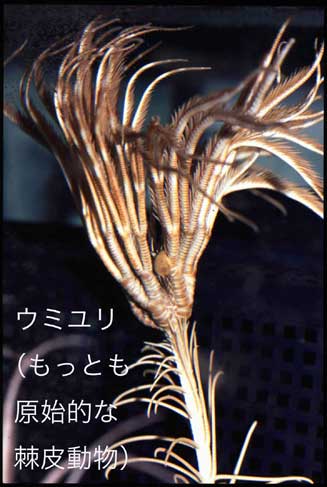About Tatsuo Motokawa (Professor Emeritus)

I have retired. The following is what I have done when I had my laboratory at Tokyo Tech.
We do research on marine invertebrates, especially on echinoderms (sea lily, sea cucumber, sea urchin, starfish, brittlestar). Echinoderms have mechanically active connective tissues. For example, sea cucumbers stiffen their body-wall connective tissue when we touch them. I named such stiffness changeable connective tissues as catch connective tissue (CCT, some other people call it 'mutable' connective tissue). CCT's are found various body parts of all the echinoderm classes. Sea lilies have another type of active connective tissues: they have contractile connective tissues at their articulations in arms, cirri, and stalks. They crawl and holds with these connective tissues.We mainly concentrate on the investigation on CCT. The studies include ultrastructure, biomechanics, physiology, and molecular mechanisms of CCT as well as anatomy and pharmacological properties of controlling nervous elements. Our detailed mechanical study revealed that CCT takes 3 different mechanical states, soft state, standard state, and stiff state. Tensilin, a 34 kDa protein isolated from sea cucumbers by Trotter and his coworkers, stiffens the holothurian dermis in the soft state to the standard state. We have isolated 20kDa protein softene (PLoS ONE 9(1):e85644, 2014). Tensilin causes aggregation of collagen fibrils and softenin antagonizes this action.The standard-state dermis further stiffens to be the stiff state. We have found new stiffening factor (NSF), a 2.4kDa protein that causes this stiffening (J. Exp. Biol. 213:3416-3422, 2010).
The noted character of catch connective tissue is in the fast and reversible changes of its mechanical properties that are controlled through nerves. We have isolated 4 neuropeptides controlling the stiffness of holothurian body wall dermis from the sea cucumber Apostichopus japonicus: NGIWYamide stiffens the dermis of the sea cucumber, holokinin 1 and 2 soften the dermis, and stichopin modulates the stiffening action of acetylcholine (Biol. Bull. 194:253-259, 1998). The immunostaining with the antibody against NGIWYamide and stichopin stained the nervous system of sea cucumbers (Proc. R. Soc.B, 266:993-1000; Proc. R. Soc.B,274:2279-2285).
The biological role of catch connective tissue is in body support. The energy needed for maintaining the stiff state is 1/10 of what contracting muscle consumes; the force CCT exerts in resisting stretch is 10 times greater than that muscles exert, which implies that CCT is 100 times more economical in body support compared with muscles. This and the large amount of extracellular materials such as ossicles explains the extremely low energy consumption of echinoderms (Biol. Bull. 216:45-54, 2009).
 Metacrinus rotundus
Metacrinus rotundus
I edited a book "Echinoid Biology" (in Japanese) and wrote several chapters including the general introduction to sea urchins. I realized at that time we know very little about how sea urchins walk and in which direction they walk, which have lead me to study the locomotory behavior of sea urchins (Mar. Biol. 154:911-948, 2008; Mar. Biol. 157:2475-2488, 2010).
One of our research interests other than echinoderms is the scaling in biology. We use the colonial ascidian Botrylloides simodensis for a model system. The colony size and the metabolic rate of this species followed the 3/4-power rule known for unitary organisms. We divided the colony. The metabolic rate of now smaller colony showed the same value that was predicted from the colony size-metabolic rate relation. We succeeded in experimental manipulation of the size of the animals for the first time in the history of scaling biology. We proposed that the 3/4-power rule derives from the self-organized criticality based on local interaction between modules comprising organisms (Proc.R. Soc.B, 272:1963-1969, 2005).
I spent 13 years in Okinawa, a southern most part of Japan, where coral reefs develop. We are currently working on the sexual and asexual reproduction of coral (Mar. Biol. 151:353-363, 2007; Zool. Sci. 24:1169-1177). We hope our study help in restoring coral reefs, now suffering destruction by human activities, crown-of-thorn starfish, and breaching.
Research projects from this lab focussed on
- morphology and biomechanics of crinoids
- reproduction of crinoids
- locomotion of echinoids
- tube-foot morphology of echinoids
- CCT(tooth ligament) of echinoids
- CCT(catch apparatus) of echinoids
- CCT(body wall) of sea cucumber
- CCT(body wall) of starfish
- energy consumption of CCT
- neuropeptides of echinoderms
- anatomy of echinoderm nervous system
- allometry of colonial ascidians
- reproduction of corals
Read more:
- Sushi Science and Hamburger Science (from Perspect. Biol. Med., vol. 32) This essay discusses the differences found in the science of the West and that in the East.
- Songs of Life (from Science, vol. 300) I am a singer-songwiter biologist. I have produced one CD and a CD book. The CD book contains 70 songs that help students memorize key words in all the fields of high school level biology.
- Recent Articles in English
E-mail Address
- tmotokawa@t06.itscom.net
